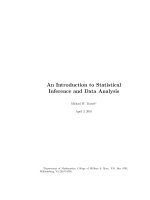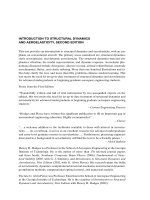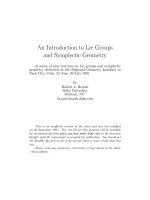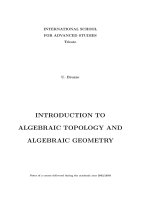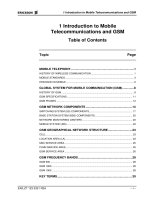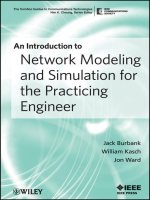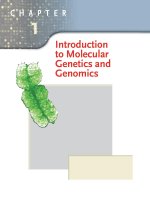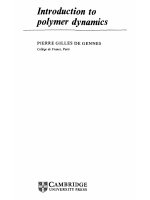INTRODUCTION TO STRUCTURAL DYNAMICS AND AEROELASTICITY potx
Bạn đang xem bản rút gọn của tài liệu. Xem và tải ngay bản đầy đủ của tài liệu tại đây (2.81 MB, 271 trang )
INTRODUCTION TO STRUCTURAL DYNAMICS
AND AEROELASTICITY, SECOND EDITION
This text provides an introduction to structural dynamics and aeroelasticity, with an em-
phasis on conventional aircraft. The primary areas considered are structural dynamics,
static aeroelasticity, and dynamic aeroelasticity. The structural dynamics material em-
phasizes vibration, the modal representation, and dynamic response. Aeroelastic phe-
nomena discussed include divergence, aileron reversal, airload redistribution, unsteady
aerodynamics, flutter, and elastic tailoring. More than one hundred illustrations and ta-
bles help clarify the text, and more than fifty problems enhance student learning. This
text meets the need for an up-to-date treatment of structural dynamics and aeroelasticity
for advanced undergraduate or beginning graduate aerospace engineering students.
Praise from the First Edition
“Wonderfully written and full of vital information by two unequalled experts on the
subject, this text meets the need for an up-to-date treatment of structural dynamics and
aeroelasticity for advanced undergraduate or beginning graduate aerospace engineering
students.”
– Current Engineering Practice
“Hodges and Pierce have written this significant publication to fill an important gap in
aeronautical engineering education. Highly recommended.”
– Choice
“ a welcome addition to the textbooks available to those with interest in aeroelas-
ticity Asatextbook, it serves as an excellent resource for advanced undergraduate
and entry-level graduate courses in aeroelasticity. Furthermore,practicingengineers
interested in a background in aeroelasticity will find the text to be a friendly primer.”
– AIAA Bulletin
Dewey H. Hodges is a Professor in the School of Aerospace Engineering at the Georgia
Institute of Technology. He is the author of more than 170 refereed journal papers
and three books, Nonlinear Composite Beam Theory (2006), Fundamentals of Struc-
tural Stability (2005, with G. J. Simitses), and Introduction to Structural Dynamics and
Aeroelasticity, First Edition (2002, with G. Alvin Pierce). His research spans the fields
of aeroelasticity, dynamics, computational structural mechanics and structural dynamics,
perturbation methods, computational optimal control, and numerical analysis.
The late G. Alvin Pierce was Professor Emeritus in the School of Aerospace Engineering
at the Georgia Institute of Technology. He is the coauthor of Introduction to Structural
Dynamics and Aeroelasticity, First Edition with Dewey H. Hodges (2002).
Cambridge Aerospace Series
Editors: Wei Shyy and Michael J. Rycroft
1. J. M. Rolfe and K. J. Staples (eds.): Flight Simulation
2. P. Berlin: The Geostationary Applications Satellite
3. M. J. T. Smith: Aircraft Noise
4. N. X. Vinh: Flight Mechanics of High-Performance Aircraft
5. W. A. Mair and D. L. Birdsall: Aircraft Performance
6. M. J. Abzug and E. E. Larrabee: Airplane Stability and Control
7. M. J. Sidi: Spacecraft Dynamics and Control
8. J. D. Anderson: A History of Aerodynamics
9. A. M. Cruise, J. A. Bowles, C. V. Goodall, and T. J. Patrick: Principles of Space
Instrument Design
10. G. A. Khoury and J. D. Gillett (eds.): Airship Technology
11. J. P. Fielding: Introduction to Aircraft Design
12. J. G. Leishman: Principles of Helicopter Aerodynamics , 2nd Edition
13. J. Katz and A. Plotkin: Low-Speed Aerodynamics, 2nd Edition
14. M. J. Abzug and E. E. Larrabee: Airplane Stability and Control: A History of
the Technologies that made Aviation Possible, 2nd Edition
15. D. H. Hodges and G. A. Pierce: Introduction to Structural Dynamics and
Aeroelasticity, 2nd Edition
16. W. Fehse: Automatic Rendezvous and Docking of Spacecraft
17. R. D. Flack: Fundamentals of Jet Propulsion with Applications
18. E. A. Baskharone: Principles of Turbomachinery in Air-Breathing Engines
19. D. D. Knight: Numerical Methods for High-Speed Flows
20. C. A. Wagner, T. H
¨
uttl, and P. Sagaut (eds.): Large-Eddy Simulation for
Acoustics
21. D. D. Joseph, T. Funada, and J. Wang: Potential Flows of Viscous and
Viscoelastic Fluids
22. W. Shyy, Y. Lian, H. Liu, J. Tang, D. Viieru: Aerodynamics of Low Reynolds
Number Flyers
23. J. H. Saleh: Analyses for Durability and System Design Lifetime
24. B. K. Donaldson: Analysis of Aircraft Structures, 2nd Edition
25. C. Segal: The Scramjet Engine: Processes and Characteristics
26. J. F. Doyle: Guided Explorations of the Mechanics of Solids and Structures
27. A. K. Kundu: Aircraft Design
28. M. I. Friswell, J. E. T. Penny, S. D. Garvey, A. W. Lees: Dynamics of Rotating
Machines
29. B. A. Conway (ed): Spacecraft Trajectory Optimization
30. R. J. Adrian and J. Westerweel: Particle Image Velocimetry
31. G. A. Flandro, H. M. McMahon, and R. L. Roach: Basic Aerodynamics
32. H. Babinsky and J. K. Harvey: Shock Wave–Boundary-Layer Interactions
Introduction to Structural Dynamics
and Aeroelasticity
Second Edition
Dewey H. Hodges
Georgia Institute of Technology
G. Alvin Pierce
Georgia Institute of Technology
cambridge university press
Cambridge, New York, Melbourne, Madrid, Cape Town,
Singapore, S
˜
ao Paulo, Delhi, Tokyo, Mexico City
Cambridge University Press
32 Avenue of the Americas, New York, NY 10013-2473, USA
www.cambridge.org
Information on this title: www.cambridge.org/9780521195904
First edition
c
Dewey H. Hodges and G. Alvin Pierce 2002
Second edition
c
Dewey H. Hodges and G. Alvin Pierce 2011
This publication is in copyright. Subject to statutory exception
and to t he provisions of relevant collective licensing agreements,
no reproduction of any part may take place without the written
permission of Cambridge University Press.
First published 2002
Second edition published 2011
Printed in the United States of America
A catalog record for this publication is available from the British Library.
Library of Congress Cataloging in Publication data
Hodges, Dewey H.
Introduction to structural dynamics and aeroelasticity / Dewey H. Hodges, G. Alvin Pierce. – 2nd ed.
p. cm. – (Cambridge aerospace series ; 15)
Includes bibliographical references and index.
ISBN 978-0-521-19590-4 (hardback)
1. Space vehicles – Dynamics. 2. Aeroelasticity. I. Pierce, G. Alvin. II. Title.
TL671.6.H565 2011
629.134
31–dc22 2011001984
ISBN 978-0-521-19590-4 Hardback
Cambridge University Press has no responsibility for the persistence or accuracy of URLs for external or
third-party Internet Web sites referred to in this publication and does not guarantee that any content on
such Web sites is, or will remain, accurate or appropriate.
Contents
Figures page xi
Tables xvii
Foreword xix
1 Introduction 1
2 Mechanics Fundamentals 6
2.1 Particles and Rigid Bodies 7
2.1.1 Newton’s Laws 7
2.1.2 Euler’s Laws and Rigid Bodies 8
2.1.3 Kinetic Energy 8
2.1.4 Work 9
2.1.5 Lagrange’s Equations 9
2.2 Modeling the Dynamics of Strings 10
2.2.1 Equations of Motion 10
2.2.2 Strain Energy 13
2.2.3 Kinetic Energy 14
2.2.4 Virtual Work of Applied, Distributed Force 15
2.3 Elementary Beam Theory 15
2.3.1 Torsion 15
2.3.2 Bending 18
2.4 Composite Beams 20
2.4.1 Constitutive Law and Strain Energy for Coupled Bending
and Torsion 21
2.4.2 Inertia Forces and Kinetic Energy for Coupled Bending
and Torsion 21
2.4.3 Equations of Motion for Coupled Bending and Torsion 22
2.5 The Notion of Stability 23
2.6 Systems with One Degree of Freedom 24
2.6.1 Unforced Motion 24
2.6.2 Harmonically Forced Motion 26
vii
viii Contents
2.7 Epilogue 28
Problems 29
3 Structural Dynamics 30
3.1 Uniform String Dynamics 31
3.1.1 Standing Wave (Modal) Solution 31
3.1.2 Orthogonality of Mode Shapes 36
3.1.3 Using Orthogonality 38
3.1.4 Traveling Wave Solution 41
3.1.5 Generalized Equations of Motion 44
3.1.6 Generalized Force 48
3.1.7 Example Calculations of Forced Response 50
3.2 Uniform Beam Torsional Dynamics 55
3.2.1 Equations of Motion 56
3.2.2 Boundary Conditions 57
3.2.3 Example Solutions for Mode Shapes and Frequencies 62
3.2.4 Calculation of Forced Response 69
3.3 Uniform Beam Bending Dynamics 70
3.3.1 Equation of Motion 70
3.3.2 General Solutions 71
3.3.3 Boundary Conditions 72
3.3.4 Example Solutions for Mode Shapes and Frequencies 80
3.3.5 Calculation of Forced Response 92
3.4 Free Vibration of Beams in Coupled Bending and Torsion 92
3.4.1 Equations of Motion 92
3.4.2 Boundary Conditions 93
3.5 Approximate Solution Techniques 94
3.5.1 The Ritz Method 94
3.5.2 Galerkin’s Method 101
3.5.3 The Finite Element Method 106
3.6 Epilogue 115
Problems 116
4 Static Aeroelasticity 127
4.1 Wind-Tunnel Models 128
4.1.1 Wall-Mounted Model 128
4.1.2 Sting-Mounted Model 131
4.1.3 Strut-Mounted Model 134
4.1.4 Wall-Mounted Model for Application to Aileron Reversal 135
4.2 Uniform Lifting Surface 139
4.2.1 Steady-Flow Strip Theory 140
4.2.2 Equilibrium Equation 141
4.2.3 Torsional Divergence 142
4.2.4 Airload Distribution 145
Contents ix
4.2.5 Aileron Reversal 148
4.2.6 Sweep Effects 153
4.2.7 Composite Wings and Aeroelastic Tailoring 163
4.3 Epilogue 167
Problems 168
5 Aeroelastic Flutter 175
5.1 Stability Characteristics from Eigenvalue Analysis 176
5.2 Aeroelastic Analysis of a Typical Section 182
5.3 Classical Flutter Analysis 188
5.3.1 One-Degree-of-Freedom Flutter 189
5.3.2 Two-Degree-of-Freedom Flutter 192
5.4 Engineering Solutions for Flutter 194
5.4.1 The k Method 195
5.4.2 The p-k Method 196
5.5 Unsteady Aerodynamics 201
5.5.1 Theodorsen’s Unsteady Thin-Airfoil Theory 203
5.5.2 Finite-State Unsteady Thin-Airfoil Theory of Peters et al. 206
5.6 Flutter Prediction via Assumed Modes 211
5.7 Flutter Boundary Characteristics 217
5.8 Structural Dynamics, Aeroelasticity, and Certification 220
5.8.1 Ground-Vibration Tests 221
5.8.2 Wind Tunnel Flutter Experiments 222
5.8.3 Ground Roll (Taxi) and Flight Tests 222
5.8.4 Flutter Flight Tests 224
5.9 Epilogue 225
Problems 225
Appendix A: Lagrange’s Equations 231
A.1 Introduction 231
A.2 Degrees of Freedom 231
A.3 Generalized Coordinates 231
A.4 Lagrange’s Equations 232
A.5 Lagrange’s Equations for Conservative Systems 236
A.6 Lagrange’s Equations for Nonconservative Systems 239
References 241
Index 243
Figures
1.1 Schematic of the field of aeroelasticity page 2
2.1 Schematic of vibrating string 10
2.2 Differential element of string showing displacement components and
tension force 10
2.3 Beam undergoing torsional deformation 16
2.4 Cross-sectional slice of beam undergoing torsional deformation 16
2.5 Schematic of beam for bending dynamics 18
2.6 Schematic of differential beam segment 18
2.7 Cross section of beam for coupled bending and torsion 22
2.8 Character of static-equilibrium positions 23
2.9 Character of static-equilibrium positions for finite disturbances 24
2.10 Single-degree-of-freedom system 24
2.11 Response for system with positive k and x(0) = x
(0) = 0.5, ζ = 0.04 26
2.12 Response for system with positive k and x(0) = x
(0) = 0.5, ζ =−0.04 26
2.13 Response for system with negative k and x(0) = 1, x
(0) = 0,
ζ =−0.05, ζ = 0, ζ = 0.05 or ζ =−0.05, 0, and 0.05 27
2.14 Magnification factor |G(i)| versus /ω for various values of ζ for a
harmonically excited system 28
2.15 Excitation f (t) (solid line) and response x(t) (dashed line) versus t
(in degrees) for ζ = 0.1 and /ω = 0.9 for a harmonically excited
system 28
3.1 First three mode shapes for vibrating string 35
3.2 Initial shape of plucked string 40
3.3 Schematic of moving coordinate systems x
L
and x
R
43
3.4 Example initial shape of wave 44
3.5 Shape of traveling wave at various times 45
3.6 Concentrated force acting on string 49
3.7 Approaching the Dirac delta function 50
3.8 Distributed force f (x, t) acting on string 51
3.9 String with concentrated force at mid-span 53
3.10 Clamped end of a beam 58
xi
xii Figures
3.11 Free end of a beam 58
3.12 Schematic of the x = end of the beam, showing the twisting moment
T, and the equal and opposite torque acting on the rigid body 59
3.13 Schematic of the x = 0 end of the beam, showing the twisting moment
T, and the equal and opposite torque acting on the rigid body 60
3.14 Example with rigid body and spring 61
3.15 Elastically restrained end of a beam 61
3.16 Inertially restrained end of a beam 62
3.17 Schematic of clamped-free beam undergoing torsion 63
3.18 First three mode shapes for clamped-free beam vibrating in torsion 64
3.19 Schematic of free-free beam undergoing torsion 65
3.20 First three elastic mode shapes for free-free beam vibrating in torsion 67
3.21 Schematic of torsion problem with spring 67
3.22 Plots of tan(α) and −α/ζ versus α for ζ = 568
3.23 Plot of the lowest values of α
i
versus ζ for a clamped-spring-restrained
beam in torsion 69
3.24 First three mode shapes for clamped-spring-restrained beam in
torsion, ζ = 170
3.25 Schematic of pinned-end condition 73
3.26 Schematic of sliding-end condition 74
3.27 Example beam undergoing bending with a spring at the x = 0 end 74
3.28 Schematic of beam with translational spring at both ends 75
3.29 Example of beam undergoing bending with a rotational spring at right
end 75
3.30 Schematic of beam with rotational springs at both ends 76
3.31 Schematic of rigid body (a) attached to end of a beam, and (b)
detached showing interactions 77
3.32 Example with rigid body attached to the right end of beam
undergoing bending 78
3.33 Example with mechanism attached to the left end of beam undergoing
bending 79
3.34 Free-body diagram for example with mechanism attached to the left
end of beam undergoing bending 80
3.35 Schematic of pinned-pinned beam 81
3.36 Schematic of clamped-free beam 82
3.37 First three free-vibration mode shapes of a clamped-free beam in
bending 84
3.38 Schematic of spring-restrained, hinged-free beam 85
3.39 Mode shapes for first three modes of a spring-restrained, hinged-free
beam in bending; κ = 1, ω
1
= (1.24792)
2
EI/( m
4
),
ω
2
= (4.03114)
2
EI/( m
4
), and ω
3
= (7.13413)
2
EI/(m
4
)87
3.40 Variation of lowest eigenvalues α
i
versus dimensionless spring
constant κ 87
Figures xiii
3.41 Mode shape for fundamental mode of the spring-restrained,
hinged-free beam in bending; κ = 50, ω
1
= (1.83929)
2
EI/(m
4
)88
3.42 Schematic of free-free beam 88
3.43 First three free-vibration elastic mode shapes of a free-free beam in
bending 90
3.44 Schematic of a nonuniform beam with distributed twisting moment
per unit length 106
3.45 Schematic of a nonuniform beam with internal torques discretized 107
3.46 Assumed twist distribution for all nodal values equal to zero except θ
i
108
3.47 Schematic of a nonuniform beam with distributed force and bending
moment per unit length 112
3.48 First elastic mode shape for sliding-free beam (Note: the “zeroth”
mode is a rigid-body translation mode) 120
3.49 Variation versus κ of (α
i
)
2
for i = 1, 2, and 3, for a beam that is free
on its right end and has a sliding boundary condition spring-restrained
in translation on its left end 120
3.50 First mode shape for a beam that is free on its right end and has a
sliding boundary condition spring-restrained in translation on its left
end with κ = 1 121
3.51 First mode shape for a beam that is clamped on its left end and pinned
with a rigid body attached on its right end with μ = 1 121
3.52 Approximate fundamental frequency for a clamped-free beam with a
particle of mass m attached at x = r 125
4.1 Planform view of a wind-tunnel model on a torsionally elastic support 128
4.2 Airfoil for wind-tunnel model 129
4.3 Relative change in lift due to aeroelastic effect 131
4.4 Plot of 1/θ versus 1/q 132
4.5 Schematic of a sting-mounted wind-tunnel model 132
4.6 Detailed view of the clamped-free beam 133
4.7 Detailed view of the sting-mounted wing 133
4.8 Schematic of strut-supported wind-tunnel model 134
4.9 Cross section of strut-supported wind-tunnel model 135
4.10 Schematic of the airfoil section of a flapped two-dimensional wing in a
wind tunnel 136
4.11 Uniform unswept clamped-free lifting surface 139
4.12 Cross section of spanwise uniform lifting surface 140
4.13 Plot of twist angle for the wing tip versus
q for α
r
+ α
r
= 1
◦
144
4.14 Rigid and elastic wing-lift distributions holding α
r
constant 147
4.15 Rigid and elastic wing-lift distributions holding total lift constant 147
4.16 Schematic of a rolling aircraft 151
4.17 Section of right wing with positive aileron deflection 151
4.18 Roll-rate sensitivity versus λ for e = 0.25c, c
β
= 0.8, and c
m
β
=−0.5,
showing the reversal point at λ = 0.984774 152
xiv Figures
4.19 Contributions to rolling moment R (normalized) from the three terms
of Eq. (4.86) 153
4.20 Schematic of swept wing (positive ) 154
4.21 Divergence dynamic pressure versus 156
4.22 Lift distribution for positive, zero, and negative 157
4.23 τ
D
versus β
D
for coupled bending-torsion divergence; solid lines
(exact solution) and dashed line (Eq. 4.104) 159
4.24 τ
D
versus r for coupled bending-torsion divergence; solid lines (exact
solution) and dashed lines (Eq. 4.107 and τ
D
=−27r
2
/4 in fourth
quadrant) 160
4.25 τ
D
versus r for coupled bending-torsion divergence; solid lines (exact
solution) and dashed lines (Eq. 4.107) 160
4.26 Normalized divergence dynamic pressure for an elastically uncoupled,
swept wing with
GJ /EI = 1.0 and e/ = 0.02 162
4.27 Normalized divergence dynamic pressure for an elastically uncoupled,
swept wing with
GJ /EI = 0.2 and e/ = 0.02 163
4.28 Normalized divergence dynamic pressure for an elastically coupled,
swept wing with
GJ /EI = 0.2 and e/ = 0.02; κ =−0.4 (dots and
dashes), κ = 0 (solid lines), κ = 0.4 (dashed lines) 167
4.29 Sweep angle for which divergence dynamic pressure is infinite for a
wing with
GJ /EI = 0.5; solid line is for e/ = 0.01; dashed line is for
e/ = 0.04 168
4.30 Sweep angle for which divergence dynamic pressure is infinite for a
wing with e / = 0.02; solid line is for
GJ /EI = 1.0; dashed line is for
GJ /EI = 0.25 168
5.1 Behavior of typical mode amplitude when
k
= 0 181
5.2 Schematic showing geometry of the wing section with pitch and
plunge spring restraints 182
5.3 Plot of the modal frequency versus V for a =−1/5, e =−1/10,
μ = 20, r
2
= 6/25, and σ = 2/5 (steady-flow theory) 186
5.4 Plot of the modal damping versus V for a =−1/5, e =−1/10, μ = 20,
r
2
= 6/25, and σ = 2/5 (steady-flow theory) 186
5.5 Schematic of the airfoil of a two-dimensional wing that is
spring-restrained in pitch 190
5.6 Comparison between p and k methods of flutter analysis for a twin-jet
transport airplane (from Hassig [1971] Fig. 1, used by permission) 199
5.7 Comparison between p and p-k methods of flutter analysis for a
twin-jet transport airplane (from Hassig [1971] Fig. 2, used by
permission) 200
5.8 Comparison between p-k and k methods of flutter analysis for a
horizontal stabilizer with elevator (from Hassig [1971] Fig. 3, used by
permission) 201
5.9 Plot of the real and imaginary parts of C(k)fork varying from zero,
where C(k) = 1, to unity 204
Figures xv
5.10 Plot of the real and imaginary parts of C(k) versus 1/k 204
5.11 Schematic showing geometry of the zero-lift line, relative wind, and
lift directions 207
5.12 Plot of the modal frequency versus U/(bω
θ
)fora =−1/5, e =−1/10,
μ = 20, r
2
= 6/25, and σ = 2/5; solid lines: p method, aerodynamics
of Peters et al.; dashed lines: steady-flow aerodynamics 211
5.13 Plot of the modal damping versus U/(bω
θ
)fora =−1/5, e =−1/10,
μ = 20, r
2
= 6/25, and σ = 2/5; solid lines: p method, aerodynamics
of Peters et al.; dashed lines: steady-flow aerodynamics 211
5.14 Plot of dimensionless flutter speed versus mass ratio for the case
σ = 1/
√
10, r = 1/2, x
θ
= 0, and a =−3/10 217
5.15 Plot of dimensionless flutter speed versus frequency ratio for the case
μ = 3, r = 1/2, and a =−1/5, where the solid line is for x
θ
= 0.2 and
the dashed line is for x
θ
= 0.1 218
5.16 Plot of dimensionless flutter speed versus e for the case μ = 10,
σ = 1/
√
2, and r = 1/2; the solid line is for a = 0 and the dashed line
is for a = 0.2 219
5.17 Flight envelope for typical Mach 2 fighter 220
5.18 Plot of ω
1,2
/ω
θ
versus U/(bω
θ
) using the k method and Theodorsen
aerodynamics with a =−1/5, e =−1/10, μ = 20, r
2
= 6/25, and
σ = 2/5 228
5.19 Plot of g versus U/(bω
θ
)usingthek method and Theodorsen
aerodynamics with a =−1/5, e =−1/10, μ = 20, r
2
= 6/25, and
σ = 2/5 228
5.20 Plot of estimated value of
1,2
/ω
θ
versus U/(bω
θ
) using the p-k
method with Theodorsen aerodynamics (dashed lines) and the p
method with the aerodynamics of Peters et al. (solid lines) for
a =−1/5, e =−1/10, μ = 20, r
2
= 6/25, and σ = 2/5 229
5.21 Plot of estimated value of
1,2
/ω
θ
versus U/(bω
θ
)usingthe p-k
method with Theodorsen aerodynamics (dashed lines) and the p
method with the aerodynamics of Peters et al. (solid lines) for
a =−1/5, e =−1/10, μ = 20, r
2
= 6/25, and σ = 2/5 229
A.1 Schematic for the mechanical system of Example 5 237
A.2 Schematic for the mechanical system of Example 6 238
Tables
3.1 Values of α
i
,(2i −1)π/2, and β
i
for i = 1, ,5 for the clamped-free
beam page 83
3.2 Values of α
i
,(2i + 1)π/2, and β
i
for i = 1, ,5 for the free-free
beam 89
3.3 Approximate values of ω
1
m
4
EI
for clamped-free beam with tip mass
of μm using n clamped-free modes of Section 3.3.4, Eq. (3.258) 99
3.4 Approximate values of ω
2
m
4
EI
for clamped-free beam with tip mass
of μm using n clamped-free modes of Section 3.3.4, Eq. (3.258) 99
3.5 Approximate values of ω
1
m
4
EI
for clamped-free beam with tip mass
of μm using n polynomial functions 100
3.6 Approximate values of ω
2
m
4
EI
for clamped-free beam with tip mass
of μm using n polynomial functions 101
3.7 Approximate values of ω
i
m
4
EI
for i = 1, 2, and 3, for a clamped-free
beam using n polynomial functions 104
3.8 Approximate values of ω
i
m
4
EI
for i = 1, 2, and 3 for a clamped-free
beam using n terms of a power series with a reduced-order equation of
motion 105
3.9 Finite-element results for the tip rotation caused by twist of a beam
with linearly varying
GJ (x) such that GJ(0) = GJ
0
= 2GJ (),
r(x, t) = r = const., and constant values of
GJ within each element 112
3.10 Approximate values of ω
1
m
4
EI
for pinned-free beam having a root
rotational spring with spring constant of κ
EI/ using one rigid-body
mode (x) and n − 1 clamped-free modes of Section 3.3.4, Eq. (3.258) 122
3.11 Approximate values of ω
2
m
4
EI
for pinned-free beam having a root
rotational spring with spring constant of κ
EI/ using one rigid-body
mode (x) and n − 1 clamped-free modes of Section 3.3.4, Eq. (3.258) 122
3.12 Approximate values of ω
1
m
4
EI
for pinned-free beam having a root
rotational spring with spring constant of κ
EI/ using one rigid-body
xvii
/>xviii Tables
mode (x) and n − 1 polynomials that satisfy clamped-free beam
boundary conditions 123
3.13 Approximate values of ω
2
m
4
EI
for pinned-free beam having a root
rotational spring with spring constant of κ
EI/ using one rigid-body
mode (x) and n − 1 polynomials that satisfy clamped-free beam
boundary conditions 123
3.14 Approximate values of ω
i
m
0
4
EI
0
for a tapered, clamped-free beam
based on the Ritz method with n polynomials that satisfy all the
boundary conditions of a clamped-free beam 124
3.15 Approximate values of ω
i
m
0
4
EI
0
for a tapered, clamped-free beam
based on the Ritz method with n terms of the form (x/)
i+1
,
i = 1, 2, ,n 124
3.16 Approximate values of ω
i
m
0
4
EI
0
for a tapered, clamped-free beam
based on the Galerkin method applied to Eq. (3.329) with n terms of
the form (x/)
i+1
, i = 1, 2, ,n 125
3.17 Finite element results for the natural frequencies of a beam in bending
with linearly varying
EI(x), such that EI(0) = EI
0
= 2EI() and
values of
EI are taken as linear within each element 126
5.1 Types of motion and stability characteristics for various values of
k
and
k
181
5.2 Variation of mass ratio for typical vehicle types 218
Foreword
From First Edition
A senior-level undergraduate course entitled “Vibration and Flutter” was taught
for many years at Georgia Tech under the quarter system. This course dealt with
elementary topics involving the static and/or dynamic behavior of structural ele-
ments, both without and with the influence of a flowing fluid. The course did not
discuss the static behavior of structures in the absence of fluid flow because this is
typically considered in courses in structural mechanics. Thus, the course essentially
dealt with the fields of structural dynamics (when fluid flow is not considered) and
aeroelasticity (when it is).
As the name suggests, structural dynamics is concerned with the vibration and
dynamic response of structural elements. It can be regarded as a subset of aero-
elasticity, the field of study concerned with interaction between the deformation of
an elastic structure in an airstream and the resulting aerodynamic force. Aeroelastic
phenomena can be observed on a daily basis in nature (e.g., the swaying of trees in
the wind and the humming sound that Venetian blinds make in the wind). The most
general aeroelastic phenomena include dynamics, but static aeroelastic phenomena
are also important. The course was expanded to cover a full semester, and the
course title was appropriately changed to “Introduction to Structural Dynamics and
Aeroelasticity.”
Aeroelastic and structural-dynamic phenomena can result in dangerous static
and dynamic deformations and instabilities and, thus, have important practical con-
sequences in many areas of technology. Especially when one is concerned with the
design of modern aircraft and space vehicles—both of which are characterized by
the demand for extremely lightweight structures—the solution of many structural
dynamics and aeroelasticity problems is a basic requirement for achieving an oper-
ationally reliable and structurally optimal system. Aeroelastic phenomena can also
play an important role in turbomachinery, civil-engineering structures, wind-energy
converters, and even in the sound generation of musical instruments.
xix
xx Foreword
Aeroelastic problems may be classified roughly in the categories of response
and stability. Although stability problems are the principal focus of the material pre-
sented herein, it is not because response problems are any less important. Rather,
because the amplitude of deformation is indeterminate in linear stability problems,
one may consider an exclusively linear treatment and still manage to solve many
practical problems. However, because the amplitude is important in response prob-
lems, one is far m ore likely to need to be concerned with nonlinear behavior when
attempting to solve them. Although nonlinear equations come closer to r epresenting
reality, the analytical solution of nonlinear equations is problematic, especially in
the context of undergraduate studies.
The purpose of this text is to provide an introduction t o the fields of structural
dynamics and aeroelasticity. The length and scope of the text are intended to be
appropriate for a semester-length, senior-level, undergraduate course or a first-year
graduate course in which the emphasis is on conventional aircraft. For curricula that
provide a separate course in structural dynamics, an ample amount of material has
been added to the aeroelasticity chapters so that a full course on aeroelasticity alone
could be developed from this text.
This text was built on the foundation provided by Professor Pierce’s course
notes, which had been used for the “Vibration and Flutter” course since the 1970s.
After Professor Pierce’s retirement in 1995, when the responsibility for the course
was transferred to Professor Hodges, the idea was conceived of turning the notes
into a more substantial text. This process began with the laborious conversion of
Professor Pierce’s original set of course notes to LaTeX format in the fall of 1997.
The authors are grateful to Margaret Ojala, who was at that time Professor Hodges’s
administrative assistant and who facilitated the conversion. Professor Hodges then
began the process of expanding the material and adding problems to all chapters.
Some of the most substantial additions were in the aeroelasticity chapters, partly
motivated by Georgia Tech’s conversion to the semester system. Dr. Mayuresh J.
Patil,
1
while he was a Postdoctoral Fellow in the School of Aerospace Engineering,
worked with Professor Hodges to add material on aeroelastic tailoring and unsteady
aerodynamics mainly during the academic year 1999–2000. The authors thank
Professor David A. Peters of Washington University for his comments on the
section that treats unsteady aerodynamics. Finally, Professor Pierce, while enjoying
his retirement and building a new house and amid a computer-hardware failure
and visits from grandchildren, still managed to add material on the history of
aeroelasticity and on the k and p-k methods in the early summer of 2001.
Dewey H. Hodges and G. Alvin Pierce
Atlanta, Georgia
June 2002
1
Presently, Dr. Patil is Associate Professor in the Department of Aerospace and Ocean Engineering
at Virginia Polytechnic and State University.
Foreword xxi
Addendum for Second Edition
Plans for the second edition were inaugurated in 2007, when Professor Pierce was
still alive. All his colleagues at Georgia Tech and in the technical community at large
were saddened to learn of his death in November 2008. Afterward, plans for the
second edition were somewhat slow to develop.
The changes made for t he second edition include additional material along
with extensive reorganization. Instructors may choose to omit certain sections
without breaking the continuity of the overall treatment. Foundational material
in mechanics and structures was somewhat expanded to make the treatment
more self-contained and collected into a single chapter. It is hoped that this new
organization will facilitate students who do not need this review to easily skip it, and
that students who do need it will find it convenient to have it consolidated into one
relatively short chapter. A discussion of stability is incorporated, along with a review
of how single-degree-of-freedom systems behave as key parameters are varied.
More detail is added for obtaining numerical solutions of characteristic equations
in structural dynamics. Students are introduced to finite-element structural models,
making the material more commensurate with industry practice. Material on control
reversal in s tatic aeroelasticity has been added. Discussion on numerical solution
of the flutter determinant via Mathematica
TM
replaces the method presented in
the first edition for interpolating from a set of candidate reduced frequencies. The
treatment of flutter analysis based on complex eigenvalues is expanded to include
an unsteady-aerodynamics model that has its own state variables. Finally, the role
of flight-testing and certification is discussed. It is hoped that the second edition
will not only maintain the text’s uniqueness as an undergraduate-level treatment of
the subject, but that it also will prove to be more useful in a first-year graduate course.
Dewey H. Hodges
Atlanta, Georgia
INTRODUCTION TO STRUCTURAL DYNAMICS
AND AEROELASTICITY, SECOND EDITION
